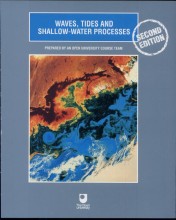Summary: Waves, Tides, And Shallow-Water Processes | 9780750642811 | John Wright, et al
- This + 400k other summaries
- A unique study and practice tool
- Never study anything twice again
- Get the grades you hope for
- 100% sure, 100% understanding
Read the summary and the most important questions on Waves, Tides, and Shallow-water Processes | 9780750642811 | John Wright; Angela Colling; Dave Park; Open University. Oceanography Course Team
-
1 Waves
This is a preview. There are 1 more flashcards available for chapter 1
Show more cards here -
What is the difference between an ocean and a sea?
Oceans have an average depth of 4000 m in stead of seas which are much shallower. Seas are on the same tectonic plates as the land. -
How does the water in an ocean circulate?
Ocean circulation is caused by High and Low pressure systems and wind. In the oceans a regular pattern of wind driven surface current gyres (wervelwind) can be found, resulting from the wind forcing. -
What does ocean stratification mean?
Layers in the ocean can not mix due to different properties as density. -
Which properties does a wave have?
Wave height (crest to trough), Amplitude (half of wave height), wavelength (distance between two successive peaks (or trough), Steepness (H/L), period (T, in s), frequency (f, amount of peaks per second), Wave number (k = 2pi/L) -
1.1 What are waves?
This is a preview. There are 2 more flashcards available for chapter 1.1
Show more cards here -
What are the characteristics of wave motion?
- A wave transfers a disturbance from one part of a material to another.
- The disturbance is propagated through the material without any substantial overall motion of the material itself.
- The disturbance is propagated without any significant distortion of the wave form.
- The disturbance appears to be propagated with constant speed. -
How is a wave generated by wind?
A wave starts with ripples due to wind stress exerted upon water surface. Wave will grow due to pressure differences at either side of the crest. A wave ceases to grow because of energy loss due to current generation, friction and white-capping. -
What kinds of waves are there and what does it mean?
- Progressive wave -> energy that is moving through or across the surface of the material. (all waves)
- Standing wave -> the sum of two progressive waves of equal dimensions, but travelling in opposite directions.
- Body wave -> wave which travel through the material. A surface wave is a body wave.
- Surface wave -> occur at the interface between atmosphere and ocean, caused by the wind blowing over the ocean. -
What are the two restoring forces which maintain wave motion in the case of surface waves on water?
- The gravitational force exerted by the earth.
- Surface tension, which is the tendency of water molecules to stick together and present the smallest possible surface to the air. -
What does significant wave height mean? And why is it used?
It is the average hieght of the highest one-third of all waves occurring in a particular time period. This is used because there is almost never an obvious pattern in waves. -
What is a fully developed sea?
It is the equilibrium in which energy is being dissipated by the waves at the same rate as the waves receive energy from the wind. Size and characteristics of the waves are not changing.
- Higher grades + faster learning
- Never study anything twice
- 100% sure, 100% understanding
Topics related to Summary: Waves, Tides, And Shallow-Water Processes
-
Waves - Wave dispersion and group speed
-
Introduction to shallow-water environments and their sediments - Sediments of shallow-water environments
-
Principles and processes of sediment transport - Factors controlling the movement of sediment
-
Principles and processes of sediment transport - Sediment erosion, transport and deposition
-
Beaches - The morphology of beaches
-
Beaches - Sediment movement in the beach zone
































